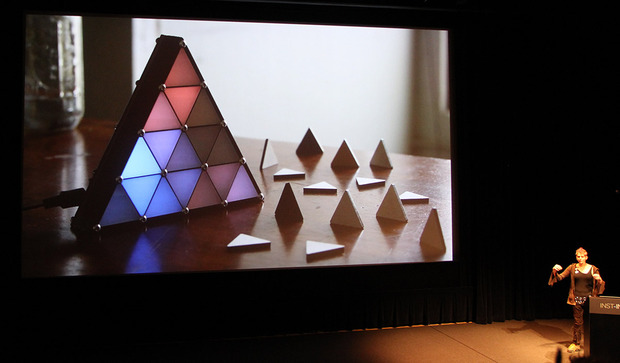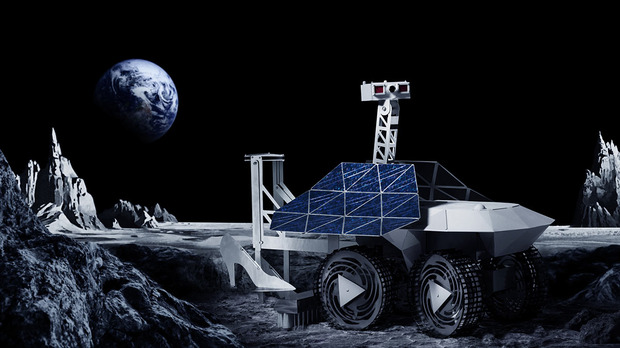INST-INT 2014: Conference Highlights
From the founders of Eyeo, this specialized forum focuses the spotlight on interactive art and technology


From the founders of technology festival Eyeo comes a smaller, more tightly focused offshoot called INST-INT. Now in its second year, the stimulating three-day experience saw roughly 300 people gravitate to Minneapolis’ Walker Art Center to glean insights from an international roster of artists, designers, architects and coders. In between talks on the challenges of creating technology-rich interactive installations and other related subjects were beneficial demos, workshops and show-and-tell sessions.
“With Eyeo, we had noticed that a lot of people who were coming were working in this field of interactive projects in the physical space, and that’s something that we’re really interested in,” co-founder Dave Schroeder tells CH. “We like to create a place where people with similar interests can get together and meet each other and form a stronger community. As people make that kind of transition from working on the screen to getting out in the physical space—it’s chock full of hurdles.”

While some of the talks naturally turned into portfolio presentations or became overly technical about the coding process, the majority of the speakers candidly revealed their own #fails, offered a fruitful message and—most interestingly—put out a call for collaborations or help with current projects. There were no boundaries between speakers and the attendees, and, as Schroeder notes, he could have a hundred more people from the audience presenting their own work on stage. Seeing how speakers (both intentionally and unintentionally) were referencing each other’s works in their talks reveals the cogs of INST-INT in motion. While the conference is decidedly advantageous for those in the interactive fields, below are some highlights from this past weekend than any creative person can gain from.
Minimaforms: Enabling Frameworks
The brothers behind experimental architecture and design practice Minimaforms, Stephen and Theodore Spyropoulos, opened up the conference with the first keynote address. They referenced Lucio Fontana’s 1946 work, “The White Manifesto,” which declared a need for a new “spatialist” art form that would go beyond architecture, painting, sculpture, music and other traditional forms: “voluminous forms changing through a plastic, mobile substance” that would engage technology to be able to express the fourth dimension. From projects like “Memory Cloud” (merging one of the oldest forms of visual communications, smoke signals, with today’s form, SMS texting) to “Petting Zoo” (robotic pets that interact with human participants and evolve or become bored over time depending on the level of engagement), Minimaforms is developing new models of interaction and communication that go beyond touching a screen.

Sputniko!: Doradical Futures with Sputniko!
When Hiromi Ozaki, more commonly known as her alter-ego Sputniko!, created a fully functioning Menstruation Machine that dispenses blood and simulates pain in the abdomen—she didn’t put it in on display in a glass case. Instead, she sings a story of a transvestite boy named Takashi who dresses up in women’s clothing but also desires to dress up biologically, too. Through music videos, Sputniko! triggers discussions of social and cultural implications of technology outside of exclusive academic or museum environments; instead, they take place in YouTube comments, Twitter feeds and other social media networks. “Popular” has a very negative image, she says, and has mistakenly become synonymous with “not very challenging.” But as platforms like YouTube have democratized who controls the media and added to the diversity of contributing voices, “pop” can be influential in pushing cultural norms—especially in Japan, which is “a little bit behind in gender equality issues.” Sputniko!’s high-heel-stamping moon rover concept—the “Moonwalk Machine“—is, for example, a response to the fact that only white American men have walked on the moon.

Kyle McDonald: Space Filling
You might have heard of media artist Kyle McDonald, whose 2011 Apple Store performance piece “People Staring at Computers” resulted in a visit from the Secret Service. He’s worked on diverse projects since, from Social Soul (where TED 2014 attendees entered inside their social media mind and were matched with their “soulmate” at the conference) to an interactive listening experience for The xx. (Probably as a reference to his Mad Libs-like webpage Who Pays Artists, McDonald also openly shared a peek of the spreadsheet breaking down the budget for that large-scale project, though banning any photos.) But McDonald also disclosed that recently, he’s been infatuated by light and the ray’s seemingly infinite qualities. Exploring some of them in his recent project Light Leaks, where 50 disco balls were used to essentially reverse-projection map a space, McDonald raced through a list of inspiring artists such as Aram Bartholl, Jussi Ängeslevä, Toshio Iwai, Anthony McCall and more, who use light in their works to astonish and provoke.

I am more through this tool than I am without it.
Daniel Leithinger: Shaping the Future of Human Computer Interfaces
“I bicycle a lot,” says Daniel Leithinger, a PhD candidate at MIT Media Lab’s Tangible Media Group. He compares the experience to being a cyborg: “I am more through this tool than I am without it.” He then poses the question of how to feel this kind of empowerment and engagement that we gain from cycling, with computers. The first step is envisioning human computer interfaces that are tangible, intuitive and engage our bodies more fully. Leithinger quotes Malcolm McCullough for inspiration: “Hands are underrated… they are not idle, just underemployed.”
Instead of having users strap themselves into a display like Oculus Rift or limiting the digital portal to a flat rectangular screen, Leithinger wants to bring “magic” into the real world. Thus far, he and his colleagues have been successful in giving digital information a dynamic, physical shape through projects like inFORM and Jamming User Interfaces (a moldable interface that “jams” or hardens temporarily by vacuum; you could knead an iPad, instead of touching it—and mold it into a tablet, game controller, watch and more).
Amsterdam sculpture project image courtesy of Janet Echelman, Moonwalk Machine courtesy of Sputniko!, inFORM image courtesy of MIT Media Lab, all other images by Nara Shin












